国际经济学----国际金融部分
国际经济学习题(国际金融)
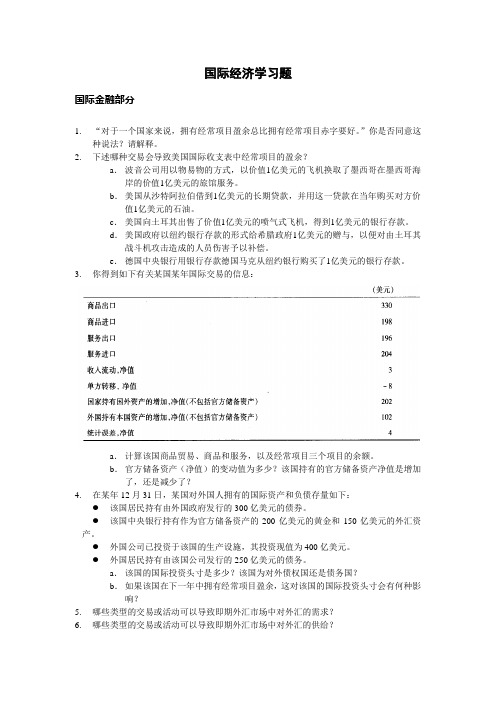
国际经济学习题国际金融部分1.“对于一个国家来说,拥有经常项目盈余总比拥有经常项目赤字要好。
”你是否同意这种说法?请解释。
2.下述哪种交易会导致美国国际收支表中经常项目的盈余?a.波音公司用以物易物的方式,以价值1亿美元的飞机换取了墨西哥在墨西哥海岸的价值1亿美元的旅馆服务。
b.美国从沙特阿拉伯借到1亿美元的长期贷款,并用这一贷款在当年购买对方价值1亿美元的石油。
c.美国向土耳其出售了价值1亿美元的喷气式飞机,得到1亿美元的银行存款。
d.美国政府以纽约银行存款的形式给希腊政府1亿美元的赠与,以便对由土耳其战斗机攻击造成的人员伤害予以补偿。
e.德国中央银行用银行存款德国马克从纽约银行购买了1亿美元的银行存款。
3.你得到如下有关某国某年国际交易的信息:a.计算该国商品贸易、商品和服务,以及经常项目三个项目的余额。
b.官方储备资产(净值)的变动值为多少?该国持有的官方储备资产净值是增加了,还是减少了?4.在某年12月31日,某国对外国人拥有的国际资产和负债存量如下:●该国居民持有由外国政府发行的300亿美元的债券。
●该国中央银行持有作为官方储备资产的200亿美元的黄金和150亿美元的外汇资产。
●外国公司已投资于该国的生产设施,其投资现值为400亿美元。
●外国居民持有由该国公司发行的250亿美元的债务。
a.该国的国际投资头寸是多少?该国为对外债权国还是债务国?b.如果该国在下一年中拥有经常项目盈余,这对该国的国际投资头寸会有何种影响?5.哪些类型的交易或活动可以导致即期外汇市场中对外汇的需求?6.哪些类型的交易或活动可以导致即期外汇市场中对外汇的供给?7.一家美国公司购买了一家日本公司的产品,因而必须向其支付100万日元。
美国公司以美元支票账户开始进行这一支付。
请解释这笔支付将如何进行,包括对即期外汇市场和两国银行的使用。
8.一家英国银行在与其客户的交易中得到一大笔美元,如果这家银行不愿继续持有这些美元,它将如何利用银行间外汇交易市场。
第二章 国际收支 《国际金融》PPT课件

2.4.1 弹性分析法
(1)弹性分析法的前提假设 (2)弹性分析法的主要内容 (3)对弹性分析法的评价 (4)贬值效应的时滞问题——J曲线效应
弹性分析法产生于20世纪30年代,由英国经济学 家琼·罗宾逊最先提出,后经美国经济学家勒纳等的 发展形成的。
该理论建立在马歇尔微观经济学和局部均衡的基 础上,把汇率水平的调整作为调节国际收支不平衡的 基本手段,围绕进出口商品的供求弹性来探讨货币贬 值改善国际收支的条件。
(3)直接管制 包括外汇管制和贸易管制
当一国国际收支不平衡时,须针对形成的原 因采取相应的政策措施
财政和货币政策:往往同国内经济目标发生 冲突
直接管制:为国际经济组织所反对,又会引 起他国的报复
2.4 国际收支调节理论
2.4.1 弹性分析法 2.4.2 吸收分析法 2.4.3 货币分析法 2.4.4 几种主要国际收支调节理论的比较
3) 对货币分析法的评价
主要贡献:
◆突破了将国际收支等同于贸易收支的局限,因
此对国际收支的分析比较全面,也比较符合经济 运行的实际情况
1)弹性分析法的前提假设
◆假定其它一切条件(利率、国民收入等)不变, 只考虑汇率变化对进出口商品的影响
◆假定存在非充分就业,贸易商品的供给具有完全 弹性
◆假定没有劳务进出口和资本流动,国际收支完全 等同于贸易收支
(2)弹性分析法的主要内容
著名的“马歇尔—勒纳条件”: 假定出口需求弹性为DX,进口需求弹性为DM, 当 DX DM >1时 货币贬值有利于改善贸易收支
3)对弹性分析法的评价
弹性分析法纠正了货币贬值一定有改善贸易收 支作用的片面看法。但是该理论也有很大的局限:
◆弹性分析法将国际收支局限于贸易收支 ◆弹性分析法以小于“充分就业” 为条件 ◆它是一种局部的均衡分析说 ◆弹性分析法是一种静态分析说 ◆技术上的困难
国际金融学绪论

金融 金融是指以金融机构为中心的货币流通和信用 活动以及与之相关的经济活动的总称。 活动以及与之相关的经济活动的总称。 关键词:金融机构、货币、信用。 关键词:金融机构、货币、信用。
1. 金融机构是专门从事货币信用活动的中 介组织。包括各类银行及非银行金融机构。 介组织。包括各类银行及非银行金融机构。 我国的金融机构: 我国的金融机构: 银行: 中央银行(中国人民银行) 银行: 中央银行(中国人民银行) 政策性银行 国家开发银行 中国进出口银行 中国农业发展银行 商业银行 国有独资商业银行 股份制商业银行 城市合作银行
三、国际金融学的形成与发展
国际金融学是在国际贸易理论的基础上逐步 形成和发展起来的, 形成和发展起来的,作为国际贸易学的一部 分而处于从属地位; 分而处于从属地位;这是因为当时的国际经 济关系以商品贸易关系为主 20世纪60年代前后, 20世纪60年代前后,国际金融开始成为一 世纪60年代前后 门新兴的学科,但其研究范围尚未明确界定 门新兴的学科,
世界经济
国 际 贸 易
主权国家经济体
所有国际经济活动实际上是国际贸易, 所有国际经济活动实际上是国际贸易, 国际贸易支撑世界经济。 国际贸易支撑世界经济。 国际金融仅仅是贸易的附庸, 国际金融仅仅是贸易的附庸,其内容 和规模有限 主要是为国际贸易服务的国际结算、 主要是为国际贸易服务的国际结算、 货币兑换和进出口信贷。 货币兑换和进出口信贷。
目前,国际投机资本的规模相当于全球产 目前,国际投机资本的规模相当于全球产 投机资本 出的20% 出的20% 每天的外汇交易规模是全球进出口贸易结 每天的外汇交易规模是全球进出口贸易结 外汇交易规模是全球 算资金额的100倍 算资金额的100倍。 国际投机资本完全脱离了实体经济, 国际投机资本完全脱离了实体经济,终日 在国际金融市场游荡, 在国际金融市场游荡,寻求并制造获利的 机会,对世界经济稳定构成现实威胁。 机会,对世界经济稳定构成现实威胁。
克鲁格曼《国际经济学》(国际金融)习题答案要点
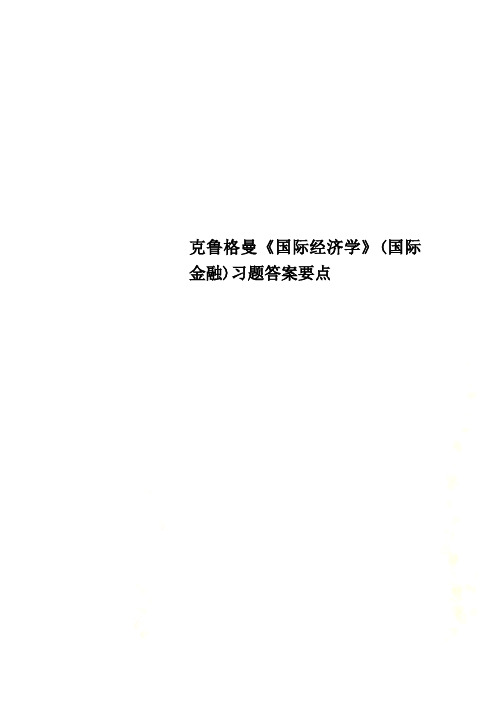
克鲁格曼《国际经济学》(国际金融)习题答案要点赤字。
因此,1982-1985年美国资本流入超过了其经常项目的赤字。
第13章 汇率与外汇市场:资产方法 1、汇率为每欧元1.5美元时,一条德国香肠bratwurst 等于三条hot dog 。
其他不变时,当美元升值至1.25$per Euro, 一条德国香肠bratwurst 等价于2.5个hot dog 。
相对于初始阶段,hot dog 变得更贵。
2、63、25%;20%;2%。
4、分别为:15%、10%、-8%。
5、(1)由于利率相等,根据利率平价条件,美元对英镑的预期贬值率为零,即当前汇率与预期汇率相等。
(2)1.579$per pound6、如果美元利率不久将会下调,市场会形成美元贬值的预期,即e E 值变大,从而使欧元存款的美元预期收益率增加,图13-1中的曲线I 移到I ',导致美元对欧元贬值,汇率从0E 升高到1E 。
131-图 7、(1)如图13-2,当欧元利率从0i 提高到1i 时,汇率从0E 调整到1E ,欧元相对于美元升值。
I 'IE 1E $/euroE图13-2(2)如图13-3,当欧元对美元预期升值时,美元存款的欧元预期收益率提高,美元存款的欧元收益曲线从I '上升到I ,欧元对美元的汇率从E '提高到E ,欧元对美元贬值。
133-图8、(a)如果美联储降低利率,在预期不变的情况下,根据利率平价条件,美元将贬值。
如图13-4,利率从i 下降到i ' ,美元对外国货币的汇价从E 提高到E ',美元贬值。
如果软着陆,并且美联储没有降低利率,则美元不会贬值。
即使美联储稍微降低利率,假如从i 降低到*i (如图13-5),这比人们开始相信会发生的还要小。
同时,由于软着陆所产生的乐观因素,使美元预期升值,即e E 值变小,使国外资产的美元预期收益率降低(曲线I 向下移动到I '),曲线移动反映了对美国软着陆引起的乐观预期,同时由乐观因素引起的预期表明:在没有预期变化的情况下,由利I 'E E 'euro/$E IiE 1E euro/$E rate of return(in euro)0i 1i率i 下降到*i 引起美元贬值程度(从E 贬值到*E )将大于存在预期变化引起的美元贬值程度(从E 到E '')。
《国际金融学》课程教学大纲

《国际金融学》课程大纲课程代码:04154005课程学分:3课程总学时:48适用专业:经济与金融专业一、课程概述(一)课程的性质《国际金融》课程,是教育部确定的“财经类专业核心课程”之一,该课程不仅是院校本科层次各专业统一开设的专业基础课和必修课,而且是金融、经济与金融专业的主干课程和基础理论课程。
国际结算、西方金融理论、外汇风险管理等涉及国际金融专业的课程都是在国际金融的基础上发展而来的。
国际金融以开放经济学为基础,研究开放经济发展中的核心问题国际收支、外汇、汇率、外汇市场、汇率制度、外汇管制、国际储备、国际金融市场、国际金融风险管理、国际资本流动与国际金融危机、国际货币体系和国际金融机构等问题,在经济、金融理论研究领域中具有举足轻重的地位。
(二)设计理念与开发思路1、促进学习者理解和重点掌握国际收支、外汇、汇率、外汇市场、汇率制度、外汇管制、国际储备、国际金融市场、国际金融风险管理、国际资本流动与国际金融危机、国际货币体系和国际金融机构的基本概念、基本理论、形成原理、控制措施、时滞效应。
2、培养学习者掌握观察和分析国内、国际发生的有关国际收支失衡、汇率变化、国际金融市场动荡、国际货币体系改革、国际资本流动动向、国际金融危机等重大国际金融问题的正确方法,培养学习者综合应用国际金融理论解决国际金融实际问题的能力。
3、提高学习者在社会科学方面的素养,树立经济一体化的核心是金融一体化的理念,掌握扎实的国际金融基础理论知识,为进一步学习国际结算、西方金融理论、外汇风险管理等其他国际金融专业课程打下必要的、坚实的理论基础。
4.该课程的考核评价方式为闭卷考试。
以百分制计分。
二、课程目标1、系统阐述国际金融的基本理论体系和框架、重点讲解国际金融的基础知识、管理原理及实务操作方法,详细阐述国际收支、外汇、汇率、外汇市场、汇率制度、外汇管制、国际储备、国际金融市场、国际金融风险管理、国际资本流动与国际金融危机、国际货币体系和国际金融机构基本概念、基本理论、形成原理、控制措施、时滞效应的基础知识和理论体系。
国际经济学导论

国际经济学导论尊敬的读者,欢迎来到本篇文章,我们将一同探讨国际经济学的基本概念、重要原理以及其在全球经济中的应用。
国际经济学是一门关于国际贸易、国际金融和国际投资等领域的学科,它研究国家之间的经济交往以及全球经济体系的运行。
一、国际贸易理论国际贸易理论是国际经济学的基础。
它主要包括比较优势理论、绝对优势理论和新贸易理论。
比较优势理论由亚当·斯密提出,它认为国际贸易的基础是各国在特定产品上的相对成本差异。
绝对优势理论由大卫·李嘉图提出,它认为国际贸易的基础是各国在不同产品上的绝对成本优势。
新贸易理论则关注于企业间的规模经济和产品差异。
二、国际货币和汇率国际经济交往中需要考虑货币和汇率因素。
固定汇率制度和浮动汇率制度是目前国际经济体系中最常见的两种货币体系。
固定汇率制度下,国家的货币与其他货币存在固定的汇率关系;而浮动汇率制度下,汇率会受到市场供求的影响而波动。
汇率的变动对国家的经济活动、国际贸易和国际资本流动都有重要影响。
三、国际金融和外汇市场国际金融涉及国家之间的资本流动和金融合作。
国际金融市场包括外汇市场、国际债券市场和国际股票市场等。
外汇市场是全球最大的金融市场之一,每天的交易规模达数万亿美元。
外汇市场的波动对国际贸易和国际投资有着重要影响,它是国际经济运行的晴雨表。
四、国际投资与跨国公司国际投资是国际经济学的重要组成部分。
它包括直接投资和间接投资两种形式。
直接投资是指企业在国外建立子公司或购买股权等方式进行的境外投资;间接投资是指通过购买股票、债券等金融工具进行的国际投资。
跨国公司在国际经济中扮演重要角色,它们的兴衰将直接影响国际经济的发展。
五、经济全球化与国际经济秩序经济全球化是当前国际经济的一个重要特征。
它使各国之间的经济联系更加紧密,促进了资源和市场的全球配置。
然而,经济全球化也带来了一系列问题,如贫富差距的扩大、环境污染等。
国际经济秩序的建立和维护对于实现经济全球化的良性发展至关重要,各国需要加强合作,共同应对挑战。
克鲁格曼《国际经济学》(国际金融)习题标准答案要点
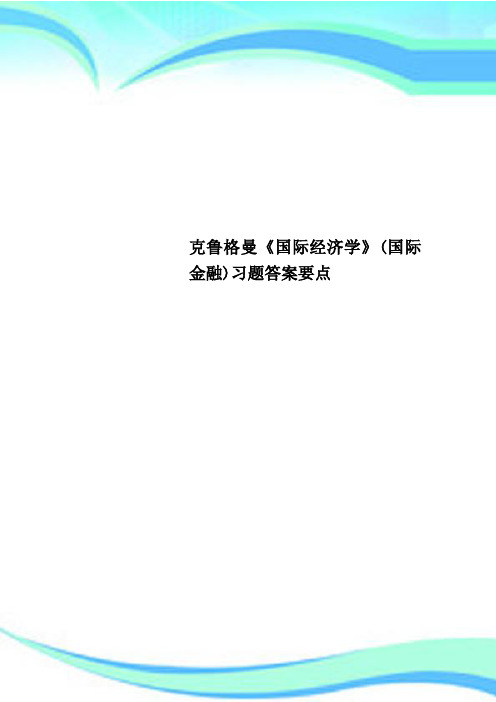
克鲁格曼《国际经济学》(国际金融)习题答案要点————————————————————————————————作者:————————————————————————————————日期:23 《国际经济学》(国际金融)习题答案要点第12章 国民收入核算与国际收支1、如问题所述,GNP 仅仅包括最终产品和服务的价值是为了避免重复计算的问题。
在国民收入账户中,如果进口的中间品价值从GNP 中减去,出口的中间品价值加到GNP 中,重复计算的问题将不会发生。
例如:美国分别销售钢材给日本的丰田公司和美国的通用汽车公司。
其中出售给通用公司的钢材,作为中间品其价值不被计算到美国的GNP 中。
出售给日本丰田公司的钢材,钢材价值通过丰田公司进入日本的GNP ,而最终没有进入美国的国民收入账户。
所以这部分由美国生产要素创造的中间品价值应该从日本的GNP 中减去,并加入美国的GNP 。
2、(1)等式12-2可以写成()()p CA S I T G =-+-。
美国更高的进口壁垒对私人储蓄、投资和政府赤字有比较小或没有影响。
(2)既然强制性的关税和配额对这些变量没有影响,所以贸易壁垒不能减少经常账户赤字。
不同情况对经常账户产生不同的影响。
例如,关税保护能提高被保护行业的投资,从而使经常账户恶化。
(当然,使幼稚产业有一个设备现代化机会的关税保护是合理的。
)同时,当对投资中间品实行关税保护时,由于受保护行业成本的提高可能使该行业投资下降,从而改善经常项目。
一般地,永久性和临时性的关税保护有不同的效果。
这个问题的要点是:政策影响经常账户方式需要进行一般均衡、宏观分析。
3、(1)、购买德国股票反映在美国金融项目的借方。
相应地,当美国人通过他的瑞士银行账户用支票支付时,因为他对瑞士请求权减少,故记入美国金融项目的贷方。
这是美国用一个外国资产交易另外一种外国资产的案例。
(2)、同样,购买德国股票反映在美国金融项目的借方。
当德国销售商将美国支票存入德国银行并且银行将这笔资金贷给德国进口商(此时,记入美国经常项目的贷方)或贷给个人或公司购买美国资产(此时,记入美国金融项目的贷方)。
经济学中的国际经济学基础知识点

经济学中的国际经济学基础知识点国际经济学是经济学中一个重要的分支,研究国家与国家之间的经济关系及其影响因素。
在这篇文章中,我们将介绍一些国际经济学的基础知识点,帮助读者更好地理解和应用这一领域的知识。
一、贸易理论1. 绝对优势理论:由亚当·斯密提出,认为一个国家在某种商品的生产上拥有绝对优势时,应专门从事该商品的生产和出口。
2. 比较优势理论:由大卫·李嘉图提出,认为即使一个国家在所有商品的生产上都不如另一个国家优势,但仍然可以通过比较优势实现贸易。
3. 因子禀赋理论:根据不同国家拥有的生产要素(如劳动力、资本等)禀赋差异,来解释贸易模式和国际分工。
二、国际货币体系1. 固定汇率制度:国家内外货币汇率固定不变,如金本位制和可兑换货币制度。
2. 浮动汇率制度:国家内外货币汇率由市场供求决定,如汇率市场的自由浮动。
3. 货币联盟:多个国家将各自的货币与某种特定比例锁定的货币挂钩,如欧元区。
三、国际投资与跨国公司1. 直接投资:投资者在境外购买或建立企业,并参与该企业的经营和管理。
2. 跨国公司:在两个或多个国家设有子公司或分支机构,进行跨国经营活动,实现资源配置和市场扩张等战略目标。
四、国际金融市场1. 外汇市场:全球性市场,涉及不同国家的货币交易,主要包括跨境支付、外汇买卖和外汇衍生品交易等。
2. 国际债券市场:指不同国家的政府和企业发行的跨境债券,如美国国债和国际公司债券等。
3. 外国直接投资市场:涉及投资者直接购买外国企业的股权或设立合资企业等。
五、国际贸易政策1. 关税:国家为保护本国产业或调节进口品与国内商品的竞争,对进口商品征收的税费。
2. 非关税壁垒:关税以外的限制进口商品的措施,如进口配额、进口许可证和技术壁垒等。
3. 自由贸易区:多个国家之间签署协定,在特定区域内实现零关税或优惠关税的贸易安排。
4. 关税同盟:多个国家签署协定,在关税方面实现一体化管理,而对非成员国保持共同关税政策。
《国际金融学》讲义(姜波克)
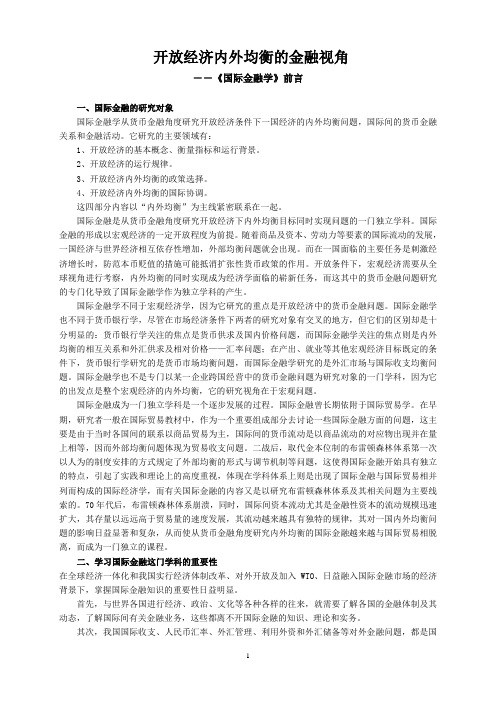
开放经济内外均衡的金融视角--《国际金融学》前言一、国际金融的研究对象国际金融学从货币金融角度研究开放经济条件下一国经济的内外均衡问题,国际间的货币金融关系和金融活动。
它研究的主要领域有:1、开放经济的基本概念、衡量指标和运行背景。
2、开放经济的运行规律。
3、开放经济内外均衡的政策选择。
4、开放经济内外均衡的国际协调。
这四部分内容以“内外均衡”为主线紧密联系在一起。
国际金融是从货币金融角度研究开放经济下内外均衡目标同时实现问题的一门独立学科。
国际金融的形成以宏观经济的一定开放程度为前提。
随着商品及资本、劳动力等要素的国际流动的发展,一国经济与世界经济相互依存性增加,外部均衡问题就会出现。
而在一国面临的主要任务是刺激经济增长时,防范本币贬值的措施可能抵消扩张性货币政策的作用。
开放条件下,宏观经济需要从全球视角进行考察,内外均衡的同时实现成为经济学面临的崭新任务,而这其中的货币金融问题研究的专门化导致了国际金融学作为独立学科的产生。
国际金融学不同于宏观经济学,因为它研究的重点是开放经济中的货币金融问题。
国际金融学也不同于货币银行学,尽管在市场经济条件下两者的研究对象有交叉的地方,但它们的区别却是十分明显的:货币银行学关注的焦点是货币供求及国内价格问题,而国际金融学关注的焦点则是内外均衡的相互关系和外汇供求及相对价格——汇率问题;在产出、就业等其他宏观经济目标既定的条件下,货币银行学研究的是货币市场均衡问题,而国际金融学研究的是外汇市场与国际收支均衡问题。
国际金融学也不是专门以某一企业跨国经营中的货币金融问题为研究对象的一门学科,因为它的出发点是整个宏观经济的内外均衡,它的研究视角在于宏观问题。
国际金融成为一门独立学科是一个逐步发展的过程。
国际金融曾长期依附于国际贸易学。
在早期,研究者一般在国际贸易教材中,作为一个重要组成部分去讨论一些国际金融方面的问题,这主要是由于当时各国间的联系以商品贸易为主,国际间的货币流动是以商品流动的对应物出现并在量上相等,因而外部均衡问题体现为贸易收支问题。
克鲁格曼 国际经济学第10版 英文答案 国际金融部分krugman_intlecon10_im_14_GE
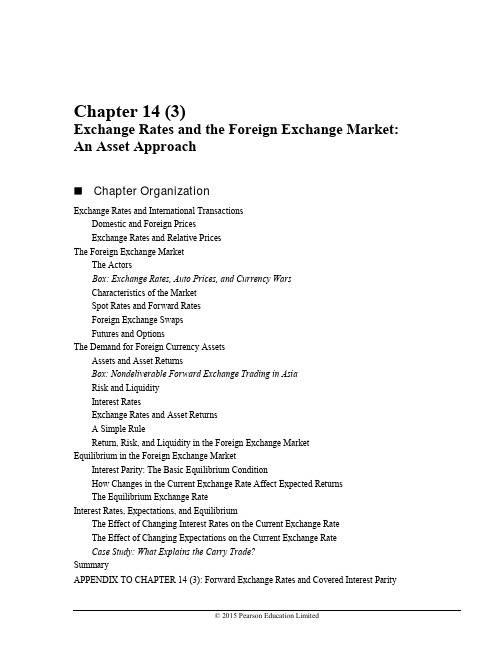
Chapter 14 (3)Exchange Rates and the Foreign Exchange Market: An Asset ApproachChapter OrganizationExchange Rates and International TransactionsDomestic and Foreign PricesExchange Rates and Relative PricesThe Foreign Exchange MarketThe ActorsBox: Exchange Rates, Auto Prices, and Currency WarsCharacteristics of the MarketSpot Rates and Forward RatesForeign Exchange SwapsFutures and OptionsThe Demand for Foreign Currency AssetsAssets and Asset ReturnsBox: Nondeliverable Forward Exchange Trading in AsiaRisk and LiquidityInterest RatesExchange Rates and Asset ReturnsA Simple RuleReturn, Risk, and Liquidity in the Foreign Exchange MarketEquilibrium in the Foreign Exchange MarketInterest Parity: The Basic Equilibrium ConditionHow Changes in the Current Exchange Rate Affect Expected ReturnsThe Equilibrium Exchange RateInterest Rates, Expectations, and EquilibriumThe Effect of Changing Interest Rates on the Current Exchange RateThe Effect of Changing Expectations on the Current Exchange RateCase Study: What Explains the Carry Trade?SummaryAPPENDIX TO CHAPTER 14 (3): Forward Exchange Rates and Covered Interest Parity© 2015 Pearson Education LimitedChapter OverviewThe purpose of this chapter is to show the importance of the exchange rate in translating foreign prices into domestic values as well as to begin the presentation of exchange rate determination. Central to the treatment of exchange rate determination is the insight that exchange rates are determined in the same way a s other asset prices. The chapter begins by describing how the relative prices of different countries’ goods are affected by exchange rate changes. This discussion illustrates the central importance of exchange rates for cross-border economic linkages. The determination of the level of the exchange rate is modeled in the context of the exchange rate’s role as the relative price of foreign and domestic currencies, using the uncovered interest parity relationship.The euro is used often in examples. Some students may not be familiar with the currency or aware of which countries use it; a brief discussion may be warranted. A full treatment of EMU and the theories surrounding currency unification appears in Chapter 20(9).The description of the foreign exchange market stresses the involvement of large organizations (commercial banks, corporations, nonbank financial institutions, and central banks) and the highly integrated natureof the market. The nature of the foreign exchange market ensures that arbitrage occurs quickly so that common rates are offered worldwide. A comparison of the trading volume in foreign exchange markets to that in other markets is useful to underscore how quickly price arbitrage occurs and equilibrium is restored. Forward foreign exchange trading, foreign exchange futures contracts, and foreign exchange options play an important part in currency market activity. The use of these financial instruments to eliminate short-run exchange rate risk is described.The explanation of exchange rate determination in this chapter emphasizes the modern view that exchange rates move to equilibrate asset markets. The foreign exchange demand and supply curves that introduce exchange rate determination in most undergraduate texts are not found here. Instead, there is a discussion of asset pricing and the determination of expected rates of return on assets denominated in different currencies.Students may already be familiar with the distinction between real and nominal returns. The text demonstrates that nominal returns are sufficient for comparing the attractiveness of different assets. There is a brief description of the role played by risk and liquidity in asset demand, but these considerations are not pursued in this chapter. (The role of risk is taken up again in Chapter 18[7].)Substantial space is devoted to the topic of comparing expected returns on assets denominated in domestic and foreign currency. The text identifies two parts of the expected return on a foreign currency asset (measured in domestic currency terms): the interest payment and the change in the value of the foreign currency relative to the domestic currency over the period in which the asset is held. The expected return on a foreign asset is calculated as a function of the current exchange rate for given expected values of the future exchange rate and the foreign interest rate.The absence of risk and liquidity considerations implies that the expected returns on all assets traded in the foreign exchange market must be equal. It is thus a short step from calculations of expected returns on foreign assets to the interest parity condition. The foreign exchange market is shown to be in equilibrium only when the interest parity condition holds. Thus, for given interest rates and given expectations about future exchange rates, interest parity determines the current equilibrium exchange rate. The interest parity diagram introduced here is instrumental in later chapters in which a more general model is presented. Because a command of this interest parity diagram is an important building block for future work, we recommend drills that employ this diagram.The result that a dollar appreciation makes foreign currency assets more attractive may appear counterintuitive to students—why does a stronger dollar reduce the expected return on dollar assets? The key to explaining this point is that, under the static expectations and constant interest rates assumptions, a dollar appreciation today implies a greater future dollar depreciation; so, an American investor can expect to gain not only theChapter 14Exchange Rates and the Foreign Exchange Market: An Asset Approach 77© 2015 Pearson Education Limitedforeign interest payment but also the extra return due to the dollar’s additional future depreciation. The following diagram illustrates this point. In this diagram, the exchange rate at time t + 1 is expected to be equal to E . If the exchange rate at time t is also E , then expected depreciation is 0. If, however, the exchange rate depreciates at time t to E ', then it must appreciate to reach E at time t + 1. If the exchange rate appreciates today to E ", then it must depreciate to reach E at time t + 1. Thus, under static expectations, a depreciation today implies an expected appreciation and vice versa.Figure 14(3)-1This pedagogical tool can be employed to provide some further intuition behind the interest parityrelationship. Suppose that the domestic and foreign interest rates are equal. Interest parity then requires that the expected depreciation is equal to zero and that the exchange rate today and next period is equal to E . If the domestic interest rate rises, people will want to hold more domestic currency deposits. The resulting increased demand for domestic currency drives up the price of domestic currency, causing the exchange rate to appreciate. How long will this continue? The answer is that the appreciation of the domestic currency continues until the expected depreciation that is a consequence of the domestic currency’s appreciation today just offsets the interest differential.The text presents exercises on the effects of changes in interest rates and of changes in expectations of the future exchange rate. These exercises can help develop students’ intuition. For example, the initial result of a rise in U.S. interest rates is a higher demand for dollar-denominated assets and thus an increase in the price of the dollar. This dollar appreciation is large enough that the subsequent expected dollar depreciation just equalizes the expected return on foreign currency assets (measured in dollar terms) and the higher dollar interest rate.The chapter concludes with a case study looking at a situation in which interest rate parity may not hold: the carry trade. In a carry trade, investors borrow money in low-interest currencies and buy high-interest-rate currencies, often earning profits over long periods of time. However, this transaction carries an element of risk as the high-interest-rate currency may experience an abrupt crash in value. The case study discusses a popular carry trade in which investors borrowed low-interest-rate Japanese yen to purchase high-interest-rate Australian dollars. Investors earned high returns until 2008, when the Australian dollar abruptly crashed, losing 40 percent of its value. This was an especially large loss as the crash occurred amidst a financial crisis in which liquidity was highly valued. Thus, when we factor in this additional risk of the carry trade, interest rate parity may still hold.The Appendix describes the covered interest parity relationship and applies it to explain the determination of forward rates under risk neutrality as well as the high correlation between movements in spot and forward rates.Answers to Textbook Problems1. At an exchange rate of 1.05 $ per euro, a 5 euro bratwurst costs 1.05$/euro ⨯ 5 euros = $5.25. Thus,the bratwurst in Munich is $1.25 more expensive than the hot dog in Boston. The relative price is $5.25/$4 = 1.31. A bratwurst costs 1.31 hot dogs. If the dollar depreciates to 1.25$/euro, the bratwurst now costs 1.25$/euro ⨯ 5 euros = $6.25, for a relative price of $6.25/$4 = 1.56. You have to give up1.56 hot dogs to buy a bratwurst. Hot dogs have become relatively cheaper than bratwurst after thedepreciation of the dollar.2. If it were cheaper to buy Israeli shekels with Swiss francs that were purchased with dollars than todirectly buy shekels with dollars, then people would act upon this arbitrage opportunity. The demand for Swiss francs from people who hold dollars would rise, causing the Swiss franc to rise in value against the dollar. The Swiss franc would appreciate against the dollar until the price of a shekel would be exactly the same whether it was purchased directly with dollars or indirectly through Swiss francs.3. Take for example the exchange rate between the Argentine peso, the US dollar, the euro, and theBritish pound. One dollar is worth 5.3015 pesos, while a euro is worth 7.0089 pesos. To rule out triangular arbitrage, we need to see how many pesos you would get if you first bought euros with your dollars (at an exchange rate of 0.7564 euros per dollar), then used these euros to buy pesos. In other words, we need to compute E D = E EUR/USD × E ARG/EUR = 0.7564× 7.0089 = 5.3015 pesos per dollar. This is almost exactly (with rounding) equal to the direct rate of pesos per dollar.Following the same procedure for the British pound yields a similar result.We need to say that triangular arbitrage is “approximately” ruled out for several reasons. First,rounding error means that there may be some small discrepancies between the direct and indirect exchange rates we calculate. Second, transactions costs on trading currencies will prevent complete arbitrage from occurring. That said, the massive volume of currencies traded make these transactions costs relatively small, leading to “near” perfect arbitrage.4. A depreciation of Chinese yuan makes the import more expensive. Since the demand for oil isinelastic, China needs to import oil from the oil exporting countries. This leads to spending more on oil when the exchange rate falls in value. This can cause the balance of payment to worsen in the short run. Hence, a depreciation of domestic currency may or may not have a favourable impact on the balance of payment in the short run.5. The dollar rates of return are as follows:a. ($250,000 - $200,000)/$200,000 = 0.25.b. ($275 - $255)/$255 = 0.08.c. There are two parts to this return. One is the loss involved due to the appreciation of the dollar;the dollar appreciation is ($1.38 - $1.50)/$1.50 =-0.08. The other part of the return is the interest paid by the London bank on the deposit, 10 percent. (The size of the deposit is immaterial to thecalculation of the rate of return.) In terms of dollars, the realized return on the London depositis thus 2 percent per year.。
国际经济学知识点整理
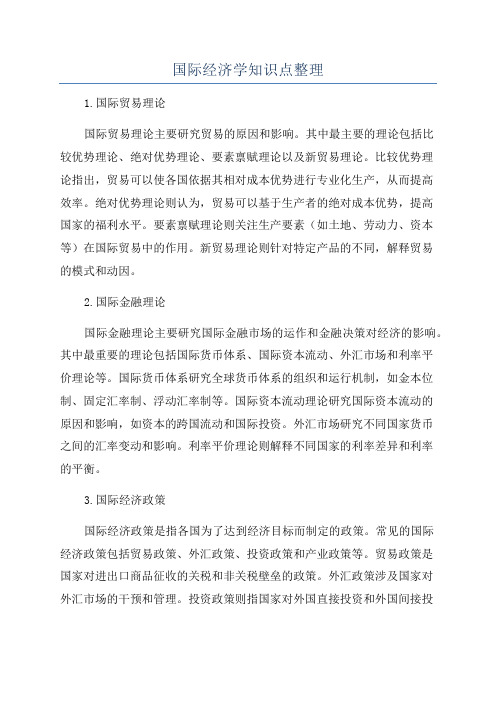
国际经济学知识点整理1.国际贸易理论国际贸易理论主要研究贸易的原因和影响。
其中最主要的理论包括比较优势理论、绝对优势理论、要素禀赋理论以及新贸易理论。
比较优势理论指出,贸易可以使各国依据其相对成本优势进行专业化生产,从而提高效率。
绝对优势理论则认为,贸易可以基于生产者的绝对成本优势,提高国家的福利水平。
要素禀赋理论则关注生产要素(如土地、劳动力、资本等)在国际贸易中的作用。
新贸易理论则针对特定产品的不同,解释贸易的模式和动因。
2.国际金融理论国际金融理论主要研究国际金融市场的运作和金融决策对经济的影响。
其中最重要的理论包括国际货币体系、国际资本流动、外汇市场和利率平价理论等。
国际货币体系研究全球货币体系的组织和运行机制,如金本位制、固定汇率制、浮动汇率制等。
国际资本流动理论研究国际资本流动的原因和影响,如资本的跨国流动和国际投资。
外汇市场研究不同国家货币之间的汇率变动和影响。
利率平价理论则解释不同国家的利率差异和利率的平衡。
3.国际经济政策国际经济政策是指各国为了达到经济目标而制定的政策。
常见的国际经济政策包括贸易政策、外汇政策、投资政策和产业政策等。
贸易政策是国家对进出口商品征收的关税和非关税壁垒的政策。
外汇政策涉及国家对外汇市场的干预和管理。
投资政策则指国家对外国直接投资和外国间接投资进行的限制和管理。
产业政策则是国家针对特定产业或产业部门进行的政策干预。
4.国际经济关系国际经济关系指的是各国之间在经济领域的相互依存关系和合作关系。
国际经济关系的主要内容包括贸易关系、金融关系、投资关系和政策协调等。
贸易关系涉及各国之间的贸易规模和贸易结构,包括贸易顺差和贸易逆差。
金融关系则包括各国之间的资本流动、国际支付和汇率的管理。
投资关系涉及各国间直接投资和间接投资的规模和结构。
政策协调是指各国之间为了达成共同目标,对经济政策进行协调和合作。
国际经济学的知识点非常广泛,上述仅列举了其中的一些重要内容。
从整体上看,国际经济学的研究包括三个层面:理论层面、政策层面和实证层面。
国际经济学的国际金融部分的选择题练习

国际经济学的国际金融部分的选择题练习C h a p t e r13:T h e B a l a n c e o f P a y m e n t sMultiple-choice Questions:1. Which of the following is false?A. A credit transaction leads to a payment from foreignersB. A debit transaction leads to a payment to foreigners*C. A credit transaction is entered with a negative signD. Double-entry bookkeeping refers to each transaction entered twice.2. Which of the following is a debit?A. The export of goodsB. The export of services*C. Unilateral transfers given to foreignersD. Capital inflows3. Capital inflows:A. refer to an increase in foreign assets in the nationB. refer to a reduction in the nation's assets abroadC. lead to a payment from foreigners*D. all of the above4. When a U.S. firm imports goods to be paid in three months the U.S. credits:A. the current accountB. unilateral transfers*C. capitalD. official reserves5. The receipt of an interest payment on a loan made by a U.S. commercial bank to a foreign resident is entered in the U.S. balance of payments as a:A. credit in the capital account*B. credit in the current accountC. credit in official reservesD. debit in unilateral transfers6. The payment of a dividend by an American company to a foreign stockholder represents:A. a debit in the U.S. capital accountB. a credit in the U.S. capital accountC. a credit in the U.S. official reserve account*D. a debit in the U.S. current account7. When a U.S. firm imports a good from England a pays for it by drawing on its poundsterling balances in a London Bank, the U.S. debits its current account and credits its:A. official reserve accountB. unilateral transfers accountC. services in its current account*D. capital account8. When the U.S. ships food aid to a developing nation, the U.S. debits:*A. unilateral transfersB. servicesC. capitalD. official reserves9. When the resident of a foreign nation (1) sells a U.S. stock and (2) deposits the proceeds in a U.S. bank, the U.S.:A. credits capital for (1) and debits capital for (2)B. credits the current account and debits capitalC. debits capital and credits official reserves*D. debits capital for (1) and credits capital for (2)10. When a U.S. resident (1) purchases foreign treasury billsand pays by (2) drawing down his bank balances abroad, the U.S.:A. debits short-term capital and credits official reserves*B. debits capital for (1) and credits capital for (2)C. debits official reserves and credits capitalD. credits short-term capital and debits official reserves11. From the U.S. point of view, drawing on (reducing) foreign bank balances in a New York bank represents a:A. capital inflow*B. capital outflowC. outflow of official reservesD. debit in the current account12. Which is not an official reserve asset of the U.S.?A. U.S. holdings of Special Drawing RightsB. The U.S. reserve position in the International Monetary Fund*C. Foreign official holdings of U.S. dollarsD. Official holdings of foreign currencies by U.S. monetary authorities13. The capital account of the U.S. includes:A. the change in U.S. assets abroad and foreign assets in the U.S.*B. the change in U.S. assets abroad and foreign assets in the U.S., other than official reserve assetsC. all financial assetsD. all but current account transactions14. Accommodating items are:A. transactions in official reserve assetsB. the items below the lineC. needed to balance international transactions*D. all of the above15. Which of the following is false?*A. a net debit balance in the current and capital accounts measures the surplus in the nation's balance of paymentsB. a balance of payments deficit must be settled by a net credit in the official reserve accountC. a deficit in the balance of payments can be measured by the excess of credits over debits in the official reserve accountD. a net debit balance in the official reserve account refers to a surplus思考题:以2009年中美两国国际收支平衡表为例,分析两国国际经济交易呈现出哪些不同特征?战后美国出现大的贸易失衡,其原因和影响是什么?中国的外汇储备量世界第一,其原因是?有何利弊?Chapter 14: Foreign Exchange Markets and Exchange Rates Multiple-choice Questions:1. Which is not a function of the foreign exchange market?A. to transfer funds from one nation to anotherB. to finance trade*C. to diversify risksD. to provide the facilities for hedging2. An increase in the pound price of the dollar represents:*A. an appreciation of the dollarB. a depreciation of the dollarC. an appreciation of the poundD. a devaluation of the dollar3. A change from $1=€1 to $2=€1 represents*A. depreciation of the dollarB. an appreciation of the dollarC. a depreciation of the poundD. none of the above4. A shortage of pounds under a flexible exchange rate system results in:A. a depreciation of the pound*B. a depreciation of the dollarC. an appreciation of the dollarD. no change in the exchange rate5. An effective exchange rate is a:A. spot rateB. forward rateC. flexible exchange rates*D. weighted average of the exchange rates between the domestic currency and the nation's most important trade partners6. The exchange rate is kept within narrow limits in different monetary centers by:A. hedging*B. exchange arbitrageC. interest arbitrageD. speculation7. If SR=$1/€1 and the three-month FR=$0.99/€1:*A. the euro is at a three-month forward discount of 1%B. the euro is at a forward discount of 1% per yearC. the euro is at a three-month forward premium of 1%D. the dollar is at a three-month forward discount of 1%8. Hedging refers to:A. the acceptance of a foreign exchange risk*B. the covering of a foreign exchange riskC. foreign exchange speculationD. foreign exchange arbitrage9. A U.S. importer scheduled to make a payment of €100,000 in three months can hedgehis foreign exchange risk by:A. purchasing $100,000 in the forward market for delivery in three monthsB. selling €100,000 in the spot market fo r delivery in three months*C. purchasing €100,000 in the forward market for delivery in three monthsD. selling €100,000 in the spot market for delivery in three months10. If the three-month FR=$1/€1 and a speculator anticipates that SR=$1.02/€1 in thre emonths, he can earn a profit by:A. selling euros forward*B. purchasing euros forwardC. selling dollars forwardD. purchasing dollars forward11. Destabilizing speculation refers to the:*A. sale of the foreign currency when the exchange rate falls or is lowB. purchase of the foreign currency when the exchange rate falls or is lowC. sale of the foreign currency when the exchange rate rises or is highD. all of the above12. A capital outflow from New York to Frankfurt under covered interest arbitrage can take place if the interest differential in favor of Frankfurt is:A. smaller than the forward discount on the euroB. equal to the forward discount on the euro*C. larger than the forward discount on the euroD. none of the above.13. According to the theory of covered interest arbitrage, if the interest differential in favor of the foreign country exceeds the forward discount on the foreign currency, there will be a:A. capital inflow under covered interest arbitrage*B. capital outflow under covered interest arbitrageC. no capital flow under a covered interest arbitrageD. any of the above14. When the interest differential in favor of the foreign country is equal to the forwardpremium on the foreign currency, we:A. are at covered interest arbitrage parity*B. are not at covered interest arbitrage parityC. may or may not be at covered interest arbitrage parityD. we cannot say without additional information15. The currency of the nation with the lower interest rate is usually at a*A. forward premiumB. forward discountC. covered interest arbitrage parityD. any of the above思考题:1. 我国外汇市场与美国等发达国家的外汇市场相比有什么不同?为什么?2. 为什么在浮动汇率之下国际收支逆差或顺差的测度并不是十分适当的?3. 如何看待以美国为首的国家要求人民币升值问题?4. 如何看待人民币国际化的前景?Chapter 15: Exchange Rate DeterminationMultiple-choice Questions:1. Which is correct with respect to the absolute PPP theory?A. It postulates that the exchange rate between two currencies is equal to the ratio of the price levels in the two nationsB. it does not take into consideration transportation costs or other obstructions to the flow of international tradeC. can be very misleading*D. all of the above2. The relative purchasing power-parity theory postulates that:A. The equilibrium exchange rate is equal to the ratio of the price level in the two nations*B. the change in the exchange rate over a period of time should be proportional to the relative change in the price level in the two nations over the same time periodC. the change in the exchange rate over a period of time should be proportional to the absolute change in the price level in the two nations over the same time periodD. the exchange rate at a period of time should be proportional to the relative prices in the two nations3. The relative PPP theory gives better results:*A. in the long run than in the short runB. when structural changes take placeC. the greater is the level of commodity aggregationD. in tests including developed and developing countries4. The monetary approach to the balance of payments:A. views the balance of payments as an essentially monetary phenomenonB. rests on the purchasing power-parity theoryC. postulates that money plays the crucial role in the long run both as a disturbance and adjustment in the nation's balance of payments*D. all of the above5. If a nation's money GDP is 100 and the velocity of circulation of money is 4, the quantity demanded of money in the nation is:A. 20*B. 25C. 50D. 1006. The monetary base of the nation refers to the:A. domestic credit created by the nation's monetary authorities or the domestic a ssets backing of the nation's money supplyB. international reserves of the nation*C. domestic credit created by the nation's monetary authorities or the domestic assets backing of the nation's money supply plus the international reserves of the nationD. legal reserve requirements in the nation7. If the legal reserve requirement of the nation is 25%, the money multiplier in the nation is:A. 2*B. 4C. 5D. 68. According to the monetary approach to the balance of payments, a deficit in the nation's balance of payments results from:*A. an excess in the nation's stock of money supply that is not eliminated or corrected by the nation's monetary authoritiesB. an excess in the stock of money demanded in the nation that is not satisfied by domestic monetary authoritiesC. an excess in the stock of money demanded in the other nation that is not satisfied by the other nation's monetary authoritiesD. an excess of imports over exports in the nation9. If the increase in a nation's money supply grows less rapidly than its GNP, the nation will face a:A. once-and-for-all balance of payments deficitB. once-and-for-all balance of payments surplusC. continuous balance of payments deficit*D. continuous balance of payments surplus10. According to the monetary approach to the balance of payments a non-reserve currency nation: *A. has no control over its money supply in the long-run under fixed exchange ratesB. has no control over its money supply in the short-run under fixed exchange ratesC. has no control over its money supply in the long-run under flexible exchange ratesD. retains complete control over its money supply in the long-run11. According to the monetary approach to the balance of payments, a surplus nation will have to give up in the long-run its goal of:A. price stabilityB. fixed exchange rate*C. price stability or fixed exchange rateD. price stability and fixed exchange rate12. Which of the following statements is true with respect to the monetary approach to the balance of payments:A. the interest differential in favor of the dollar equals the expected rate of appreciation of the euroB. the interest differential in favor of the dollar equals the expected rate of depreciation of the dollarC. the interest differential in favor of the pound equals the expected rate of depreciation of the pound*D. all of the above13. The monetary approach assumes that the following assumption holds:*A. domestic and foreign bonds are perfect substitutesB. covered interest arbitrage holdsC. expectations do not affect the future spot exchange rate.D. the risk premium is positive14. The portfolio balance approach:A. can be regarded as an extension of the monetary approachB. deals with money and other domestic and foreign financial assetsC. can more readily be extended than the monetary approach to deals with the real sector*D. all of the above15. According to the portfolio balance approach, an increase in the expected appreciation of the foreign currency leads domestic residents to increase:A. the demand for domestic moneyB. the demand for the domestic bond*C. the demand for the foreign bondD. the risk premium16. According to the portfolio balance approach, a reduction in the risk premium on the foreign bond leads domestic residents to increase the demand for the:A. domestic moneyB. domestic bond*C. foreign bondD. all of the above17. According to the portfolio balance approach, an increase in domestic real income or GDP leads domestic residents to increase the demand for the:*A. domestic moneyB. domestic bondC. foreign bondD. all of the above18. According to the portfolio balance approach, an increase in domestic wealth leads domestic residents to increase the demand for the:A. domestic moneyB. domestic bondC. foreign bond*D. all of the above19. Which of the following is false with regard to exchange rate dynamics:A. seeks to explain exchange rate fluctuations over time*B. results because the real sector adjusts instantaneously to disturbancesC. in the short run, the exchange rate overshoots its long-run equilibriumD. results from the stock adjustment in financial assets20. An unexpected increase in the U.S. money supply leadsto:A. an immediate reduction in the U.S. interest rateB. an immediate larger dollar depreciationC. a gradual appreciation of the dollar over time*D. all of the above思考题:现代汇率理论和传统汇率理论格式什么?他们有何区别?每一种理论的实质是什么?他们之间的关系如何?什么是购买力平价理论?它包括哪两种形式?各有何作用?如何对它们进行经验检验?结果如何?根据货币分析法,在辅导汇率替下下,什么决定了汇率的至极其变得?从货币分析法的观点出发,与浮动汇率体系和固定汇率体系相比,有管理的浮动汇率体系有何特点?资产市场分析法与货币分析法有何不同?两者是怎样解释在当今外汇市场中经常出现的汇率超调的?经验检验是支持还是拒绝者两种观点?我们还需要做哪些理论和经验的工作?在可预见的将来,这种工作的成果将是什么?PART FOUR:OPEN ECONOMY MACROECONOMICS AND THE INTERNATIONAL MONETARY SYSTEMChapter 16: The Price Adjustment Mechanisms with Flexible and Fixed Exchange RatesMultiple-choice Questions:1. The more elastic is a nation's demand and supply of foreign exchange the:A. larger is the devaluation or depreciation required to correct a deficit of a given size in the nation's balance of payments*B. smaller is the devaluation or depreciation required to correct a deficit of a given size in the nation's balance of paymentsC. less feasible is a flexible exchange rate systemD. less feasible is a devaluation as a policy to correct a deficit in the nation's balance of payments2. A nation's demand curve for foreign exchange is derived from the:A. foreign demand curve for the nations' exportsB. nation's supply curve of exports*C. domestic demand curve for imports and the foreign supply curve for the nation's importsD. foreign demand curve and the domestic supply curve for the nation's exports3. A depreciation of a nation's currency shifts:A. down its supply curve of imports in terms of the foreign currencyB. up its demand curve of imports in terms of the foreign currency*C. down its demand curve of imports in terms of the foreign currencyD. down its demand curve of imports in terms of the domestic currency4. When a nation's demand curve for imports in terms of the foreign currency is vertical: *A. the nation's demand curve for the foreign currency has zero elasticityB. the nation's demand for the currency is elasticC. the nation's supply of the currency is verticalD. the other nation's demand for the nation's currency has zero elasticity5. A depreciation of a nation's currency shifts:A. down its supply curve of exports in terms of the domestic currency*B. down its supply curve of exports in terms of the foreign currencyC. down its demand curve for exports in terms of the foreign currencyD. up its supply curve of imports in terms of the foreign currency6. When a nation's demand curve for exports in terms of the foreign currency is inelastic: *A. the nation's supply curve of the foreign currency is negatively inclinedB. the nation's supply curve of the foreign currency is verticalC. the nation's demand curve for the foreign currency is negatively inclinedD. the other nation's supply curve of the nation's currency is negatively inclined7. For a small nation:A. the foreign supply of exports is horizontalB. the domestic demand for imports is horizontal*C. the foreign demand for its exports is horizontalD. the foreign supply of exports is vertical8. A depreciation of the nation's currency causes its terms of trade to:A. deteriorateB. improveC. remain unchanged*D. any of the above9. A depreciation of a nation's currency is:*A. inflationary for the nationB. deflationary for the nationC. deflationary for the trade partnerD. any of the above10. The foreign exchange market is stable when:A. The demand curve of foreign exchange is negatively inclined and the supply curve of foreign exchange is positively inclinedB. the supply curve of foreign exchange is negatively inclined and less elastic than the demand curveC. the sum of the absolute values of the elasticity of the nation's demand of imports and the foreign demand for the nation's exports is greater than one*D. all of the above11. The United States has a trade problem with Japan because the U.S. trade deficit with Japan:A. is very largeB. has persisted for a long timeC. did not seem to decline when the dollar depreciated sharply with respect to the yen*D. all of the above12. The mint parity refers to the:A. gold export pointB. gold import pointC. equilibrium exchange rate*D. ratio of the price of a unit of gold in terms of the currency of two nations13. Under the gold standard:A. each nations defines the price of gold in terms of its currency and then stands ready to buy and sell any amount of gold at that priceB. there is a fixed relationship between any two currencies called the mint parityC. the exchange rate is determined by demand and supplybetween the gold points and is prevented from moving outside the gold points by gold shipmentsD. all of the above14. Which of the following statements is not true with regard to the price-specie-flow mechanism:A. relies on the quantity theory of moneyB. requires that nations allow their money supply to rise when the nation has a surplus in its balance of payments and to fall when the nation has a deficit*C. requires that the price elasticity of demand for imports and exports be equal to zeroD. it was introduced by David Hume to show the futility of the mercantilists' prescription that a nation should attempt to continuously accumulate gold15. A currency board refers to the case where:A. the central bank sterilizes changes in the money supply resulting from balance of payments disequilibria*B. the money supply of the nation is backed by 100 percent international reservesC. the nation operates under flexible exchange ratesD. the nation retains firm control over its money supply思考题:贬值为什么会带来通货膨胀趋势?为的外汇市场的马歇尔-勒纳条件是什么?贬值能否不改变国际收支状况?弹性悲观主义背着注意的含义是?它是怎么产生的?为什么不合理?针对外汇市场的稳定性以及外汇供求曲线的弹性,目前普遍的官邸时什么?什么是货币传递?它与国际竞争有什么关系?Chapter 17: The Income Adjustment Mechanism andSynthesis of Automatic AdjustmentsMultiple-choice Questions:1. In order to isolate the income adjustment mechanism, we assume that:A. the nation operates under a fixed exchange rate systemB. all prices, wages, and interest rates are constantC. the nation operates at less than full employment*D. all of the above2. The marginal propensity to consume measures:A. the ratio of imports to incomeB. the ratio of income to imports*C. the change in imports over the change in incomeD. the change in income over the change in imports3. The income elasticity of imports is given by:A. the percentage change in income over the percentage change in importsB. the change in imports over the change in income*C. the marginal propensity to import over the average propensity to importD. the average propensity to import over the marginal propensity to import4. The equilibrium level of national income in an open economy is given by:A. I + X = S + MB. X - M = S - IC. I + (X-M) = S*D. all of the above5. If MPS=0.2 and MPM=0.3, the foreign trade multiplier is:A. 5B. 3.3C. 3*D. 26. When S exceeds I, an open economy has a trade balance:*A. surplusB. deficitC. equilibriumD. any of the above7. The S-I function rises because:A. rising I are subtracted from constant S*B. constant I are subtracted from rising SC. rising I are subtracted from rising SD. constant I are added to falling S8. An autonomous fall in M from a condition of equilibrium in national income and in thetrade balance results in the nation's income:A. rising and its trade balance turning to deficitB. falling and its trade balance turning into surplus*C. rising and its trade balance turning into surplusD. rising and the trade balance remaining in equilibrium9. An autonomous increase in S from a condition of equilibrium in national income and in thetrade balance results in the nation's income:A. rising and its trade balance turning into surplus*B. falling and its trade balance turning into surplusC. falling and its trade balance turning into deficitD. rising and its trade balance turning into deficit10. The foreign trade multiplier of nation 1 is largest:A. when there are no foreign repercussionsB. with foreign repercussions for an autonomous increase in nation 1's X that replace domestic production in nation 2*C. with foreign repercussions for an autonomous increase in I in nation 1D. with foreign repercussions for an autonomous increase inI in nation 211. By itself, the automatic income adjustment mechanism is likely to bring about:*A. incomplete adjustmentB. complete adjustmentC. perverse adjustmentD. any of the above12. A depreciation of a deficit nation's currency from a condition of full employment:*A. may improve the nation's trade balanceB. will improve the nation's trade balanceC. will leave the nation's trade balance unchangedD. will cause a deterioration in the nation's trade balance13. The improvement in a nation's balance of trade and payments resulting from a depreciationof its currency is:A. reinforced by the induced fall in imports*B. partly neutralized by the induced rise in importsC. partly neutralized by the induced fall in importsD. any of the above.14. In the real world, the automatic income, price, and interest adjustment mechanisms, ifallowed to operate, are likely to:A. reinforce each other but still result in incomplete adjustment*B. reinforce each other and result in complete adjustmentC. work at cross purposes from each other and result inincomplete adjustmentD. work at cross purposes from each other and result in perverse adjustment15. A benefit of automatic adjustment mechanisms is that they:A. avoid the possibility of policy mistakesB. avoid the time lags associated with adjustment policiesC. begin to operate as soon as balance of payments disequilibria develop*D. all of the above思考题:自动收入调节机制怎样调节一国的国际收支?为单独分析该机制,我们假定哪些变量不变?怎样理解自动收入调节机制带来贸易差额的不完全调节?什么是弹性法与吸收法?吸收法如何把自动价格与收入调节机制综合起来?从充分就业开始,如果允许逆差国货币贬值,其贸易差额将会怎样?实际国内吸收如何才能减少?什么事自动货币调节?他们如何帮助调节国际收支失衡?在固定或有管理的汇率制度下,如果一国处于非充分就业,所有的自动调节机制如何共同调节其国际收支逆差?每种自动调节机制的缺点是什么?Chapter 18: Open Economy Macroeconomics: Adjustment PoliciesMultiple-choice Questions:1. The most important economic objective of industrial nations is:A. external balance*B. internal balanceC. a reasonable rate of growthD. an equitable distribution of income2. In order to achieve internal and external balance simultaneously, a nation must usually use at least:A. one policy*B. two policiesC. three policiesD. cannot say3. Points below internal balance line YY in the Swan diagram indicate:A. a balance of payments deficitB. a balance of payments surplus*C. unemploymentD. inflation4. To correct a balance of payments deficit and unemployment a nation requires a:A. devaluation and expansionary fiscal and monetary policiesB. devaluation and contractionary fiscal and monetary policies*C. devaluation and either expansionary or contractionary fiscal and monetary policiesD. revaluation and either expansionary or contractionary fiscal and monetary policies5. To correct a balance of payments deficit and inflation a nation requires a:A. devaluation and expansionary fiscal and monetary policiesB. devaluation and contractionary fiscal and monetary policies*C. devaluation or revaluation and contractionary fiscal and monetary policiesD. revaluation and either expansionary or contractionaryfiscal and monetary policies6. To correct a balance of payments surplus and unemployment a nation requires a:A. devaluation and expansionary fiscal and monetary policiesB. devaluation and contractionary fiscal and monetary policies*C. devaluation or revaluation and expansionary fiscal and monetary policiesD. revaluation and either expansionary or contractionary fiscal and monetary policies7. To correct a balance of payments surplus and inflation a nation requires a:A. devaluation and expansionary fiscal and monetary policiesB. devaluation and contractionary fiscal and monetary policies*C. devaluation and either expansionary or contractionary fiscal and monetary policiesD. revaluation and either expansionary or contractionary fiscal and monetary policies8. The IS curve is negatively inclined because:A. the higher is the rate of interest the smaller is the quantity of money demanded for speculative purposesB. higher rates of interest lead to greater capital flows*C. at lower interest rates the levels of investment and national income are higherD. at lower interest rates the level of national income is lower9. If the BP curve is above the point of intersection of the IS and LM curves, the nation will: *A. have a balance of payments deficit at that level of incomeB. have a balance of payments surplus at that level of income。
克鲁格曼《国际经济学》(国际金融部分)课后习题答案(英文版)第一章

CHAPTER 1INTRODUCTIONChapter OrganizationWhat is International Economics About?The Gains from TradeThe Pattern of TradeProtectionismThe Balance of PaymentsExchange-Rate DeterminationInternational Policy CoordinationThe International Capital MarketInternational Economics: Trade and MoneyCHAPTER OVERVIEWThe intent of this chapter is to provide both an overview of the subject matter of international economics and to provide a guide to the organization of the text. It is relatively easy for an instructor to motivate the study of international trade and finance. The front pages of newspapers, the covers of magazines, and the lead reports of television news broadcasts herald the interdependence of the U.S. economy with the rest of the world. This interdependence may also be recognized by students through their purchases of imports of all sorts of goods, their personal observations of the effects of dislocations due to international competition, and their experience through travel abroad.The study of the theory of international economics generates an understanding of many key events that shape our domestic and international environment. In recent history, these events include the causes and consequences of the large current account deficits of the United States; the dramatic appreciation of the dollar during the first half of the 1980s followed by its rapid depreciation in the second half of the 1980s; the Latin American debt crisis of the 1980s and the Mexico crisis in late 1994; and the increased pressures for industry protection against foreign competition broadly voiced in the late 1980s and more vocally espoused in the first half of the 1990s. Most recently, the financial crisis that began in East Asia in 1997 andspread to many countries around the globe and the Economic and Monetary Union in Europe have highlighted the way in which various national economies are linked and how important it is for us to understand these connections. At the same time, protests at global economic meetings have highlighted opposition to globalization. The text material will enable students to understand the economic context in which such events occur.Chapter 1 of the text presents data demonstrating the growth in trade and increasing importance of international economics. This chapter also highlights and briefly discusses seven themes which arise throughout the book. These themes include: 1) the gains from trade;2) the pattern of trade; 3) protectionism; 4), the balance of payments; 5) exchange rate determination; 6) international policy coordination; and 7) the international capital market. Students will recognize that many of the central policy debates occurring today come under the rubric of one of these themes. Indeed, it is often a fruitful heuristic to use current events to illustrate the force of the key themes and arguments which are presented throughout the text.。
国际经济学章节知识点总结
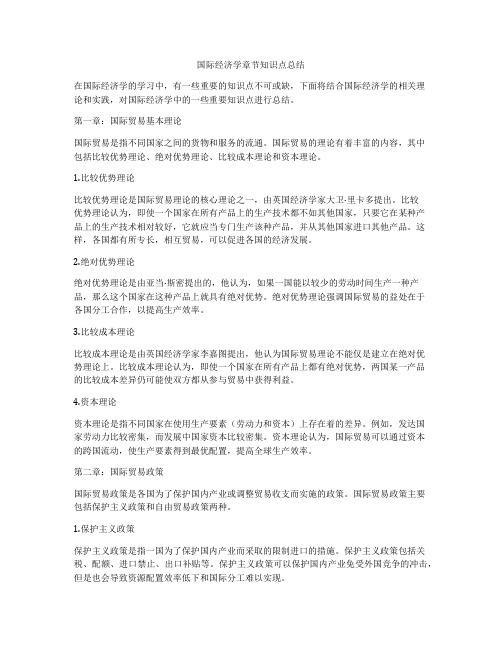
国际经济学章节知识点总结在国际经济学的学习中,有一些重要的知识点不可或缺,下面将结合国际经济学的相关理论和实践,对国际经济学中的一些重要知识点进行总结。
第一章:国际贸易基本理论国际贸易是指不同国家之间的货物和服务的流通。
国际贸易的理论有着丰富的内容,其中包括比较优势理论、绝对优势理论、比较成本理论和资本理论。
1.比较优势理论比较优势理论是国际贸易理论的核心理论之一,由英国经济学家大卫·里卡多提出。
比较优势理论认为,即使一个国家在所有产品上的生产技术都不如其他国家,只要它在某种产品上的生产技术相对较好,它就应当专门生产该种产品,并从其他国家进口其他产品。
这样,各国都有所专长,相互贸易,可以促进各国的经济发展。
2.绝对优势理论绝对优势理论是由亚当·斯密提出的,他认为,如果一国能以较少的劳动时间生产一种产品,那么这个国家在这种产品上就具有绝对优势。
绝对优势理论强调国际贸易的益处在于各国分工合作,以提高生产效率。
3.比较成本理论比较成本理论是由英国经济学家李嘉图提出,他认为国际贸易理论不能仅是建立在绝对优势理论上。
比较成本理论认为,即使一个国家在所有产品上都有绝对优势,两国某一产品的比较成本差异仍可能使双方都从参与贸易中获得利益。
4.资本理论资本理论是指不同国家在使用生产要素(劳动力和资本)上存在着的差异。
例如,发达国家劳动力比较密集,而发展中国家资本比较密集。
资本理论认为,国际贸易可以通过资本的跨国流动,使生产要素得到最优配置,提高全球生产效率。
第二章:国际贸易政策国际贸易政策是各国为了保护国内产业或调整贸易收支而实施的政策。
国际贸易政策主要包括保护主义政策和自由贸易政策两种。
1.保护主义政策保护主义政策是指一国为了保护国内产业而采取的限制进口的措施。
保护主义政策包括关税、配额、进口禁止、出口补贴等。
保护主义政策可以保护国内产业免受外国竞争的冲击,但是也会导致资源配置效率低下和国际分工难以实现。
克鲁格曼《国际经济学》(国际金融)习题标准答案要点

克鲁格曼《国际经济学》(国际金融)习题答案要点————————————————————————————————作者:————————————————————————————————日期:23 《国际经济学》(国际金融)习题答案要点第12章 国民收入核算与国际收支1、如问题所述,GNP 仅仅包括最终产品和服务的价值是为了避免重复计算的问题。
在国民收入账户中,如果进口的中间品价值从GNP 中减去,出口的中间品价值加到GNP 中,重复计算的问题将不会发生。
例如:美国分别销售钢材给日本的丰田公司和美国的通用汽车公司。
其中出售给通用公司的钢材,作为中间品其价值不被计算到美国的GNP 中。
出售给日本丰田公司的钢材,钢材价值通过丰田公司进入日本的GNP ,而最终没有进入美国的国民收入账户。
所以这部分由美国生产要素创造的中间品价值应该从日本的GNP 中减去,并加入美国的GNP 。
2、(1)等式12-2可以写成()()p CA S I T G =-+-。
美国更高的进口壁垒对私人储蓄、投资和政府赤字有比较小或没有影响。
(2)既然强制性的关税和配额对这些变量没有影响,所以贸易壁垒不能减少经常账户赤字。
不同情况对经常账户产生不同的影响。
例如,关税保护能提高被保护行业的投资,从而使经常账户恶化。
(当然,使幼稚产业有一个设备现代化机会的关税保护是合理的。
)同时,当对投资中间品实行关税保护时,由于受保护行业成本的提高可能使该行业投资下降,从而改善经常项目。
一般地,永久性和临时性的关税保护有不同的效果。
这个问题的要点是:政策影响经常账户方式需要进行一般均衡、宏观分析。
3、(1)、购买德国股票反映在美国金融项目的借方。
相应地,当美国人通过他的瑞士银行账户用支票支付时,因为他对瑞士请求权减少,故记入美国金融项目的贷方。
这是美国用一个外国资产交易另外一种外国资产的案例。
(2)、同样,购买德国股票反映在美国金融项目的借方。
当德国销售商将美国支票存入德国银行并且银行将这笔资金贷给德国进口商(此时,记入美国经常项目的贷方)或贷给个人或公司购买美国资产(此时,记入美国金融项目的贷方)。
经济学系《国际经济学》课程教学大纲
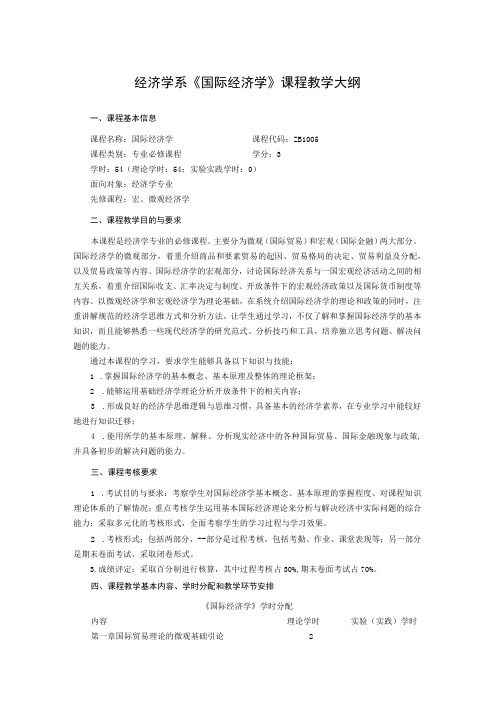
经济学系《国际经济学》课程教学大纲一、课程基本信息课程名称:国际经济学课程代码:ZB1005课程类别:专业必修课程学分:3学时:54(理论学时:54;实验实践学时:0)面向对象:经济学专业先修课程:宏、微观经济学二、课程教学目的与要求本课程是经济学专业的必修课程。
主要分为微观(国际贸易)和宏观(国际金融)两大部分。
国际经济学的微观部分,着重介绍商品和要素贸易的起因、贸易格局的决定、贸易利益及分配,以及贸易政策等内容。
国际经济学的宏观部分,讨论国际经济关系与一国宏观经济活动之间的相互关系,着重介绍国际收支、汇率决定与制度、开放条件下的宏观经济政策以及国际货币制度等内容。
以微观经济学和宏观经济学为理论基础,在系统介绍国际经济学的理论和政策的同时,注重讲解规范的经济学思维方式和分析方法,让学生通过学习,不仅了解和掌握国际经济学的基本知识,而且能够熟悉一些现代经济学的研究范式、分析技巧和工具,培养独立思考问题、解决问题的能力。
通过本课程的学习,要求学生能够具备以下知识与技能:1.掌握国际经济学的基本概念、基本原理及整体的理论框架;2.能够运用基础经济学理论分析开放条件下的相关内容;3.形成良好的经济学思维逻辑与思维习惯,具备基本的经济学素养,在专业学习中能较好地进行知识迁移;4.能用所学的基本原理,解释、分析现实经济中的各种国际贸易、国际金融现象与政策,并具备初步的解决问题的能力。
三、课程考核要求1.考试目的与要求:考察学生对国际经济学基本概念、基本原理的掌握程度、对课程知识理论体系的了解情况;重点考核学生运用基本国际经济理论来分析与解决经济中实际问题的综合能力;采取多元化的考核形式,全面考察学生的学习过程与学习效果。
2.考核形式:包括两部分,--部分是过程考核,包括考勤、作业、课堂表现等;另一部分是期末卷面考试,采取闭卷形式。
3.成绩评定:采取百分制进行核算,其中过程考核占30%,期末卷面考试占70%。
丹尼斯国际经济学国际金融分册课后习题
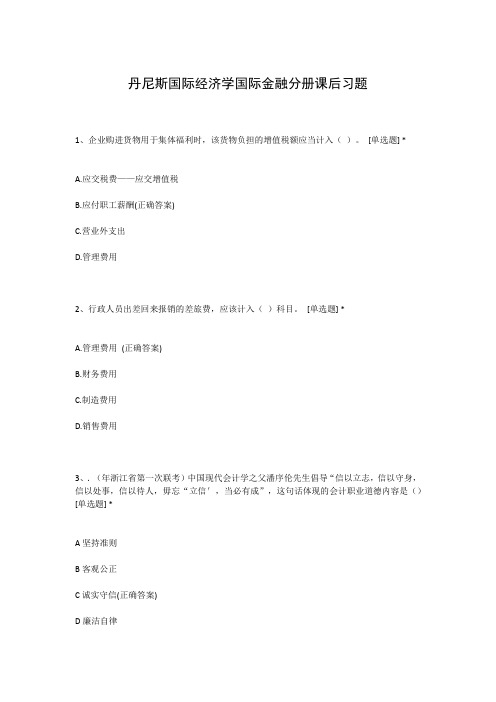
丹尼斯国际经济学国际金融分册课后习题1、企业购进货物用于集体福利时,该货物负担的增值税额应当计入()。
[单选题] *A.应交税费——应交增值税B.应付职工薪酬(正确答案)C.营业外支出D.管理费用2、行政人员出差回来报销的差旅费,应该计入()科目。
[单选题] *A.管理费用(正确答案)B.财务费用C.制造费用D.销售费用3、.(年浙江省第一次联考)中国现代会计学之父潘序伦先生倡导“信以立志,信以守身,信以处事,信以待人,毋忘“立信',当必有成”,这句话体现的会计职业道德内容是()[单选题] *A坚持准则B客观公正C诚实守信(正确答案)D廉洁自律4、当法定盈余公积达到注册资本的()时,可以不再提取。
[单选题] *A.10%B.20%C.50%(正确答案)D.30%5、.(年浙江省第二次联考)会计人员的职业道德规范不包括()[单选题] *A操守为重、不做假账(正确答案)B爱岗敬业、诚实守信C、廉洁自律、客观公正D坚持准则、提高技能6、企业用盈余公积转增资本时,转增后留存的盈余公积的数额不得少于转增前注册资本()。
[单选题] *A.20%B.15%C.25%(正确答案)D.50%7、商标权有法定有效期限,一般商标权的有效期限为()。
[单选题] *A.5年B.10年(正确答案)C.15年D.20年8、计提固定资产折旧时,可以先不考虑固定资产残值的方法是()。
[单选题] *A.年限平均法B.工作量法C.双倍余额递减法(正确答案)D.年数总和法9、.(年浙江省第三次联考)下列不属于企业事前核算主要形式的是()[单选题] * A进行预测B参与计划C、进行控制(正确答案)D参与决策10、下列交易和事项中,不应确认为营业外支出的是()。
[单选题] *A.对外捐赠支出B.债务重组损失C.计提的存货跌价准备(正确答案)D.处置报废固定资产损失11、股份有限公司为核算投资者投入的资本应当设置()科目。
[单选题] *A.“实收资本”B.“股东权益”C.“股本”(正确答案)D.“所有者权益”12、委托加工应纳消费税产品(非金银首饰)收回后,如直接对外销售,其由受托方代扣代交的消费税,应计入()。
- 1、下载文档前请自行甄别文档内容的完整性,平台不提供额外的编辑、内容补充、找答案等附加服务。
- 2、"仅部分预览"的文档,不可在线预览部分如存在完整性等问题,可反馈申请退款(可完整预览的文档不适用该条件!)。
- 3、如文档侵犯您的权益,请联系客服反馈,我们会尽快为您处理(人工客服工作时间:9:00-18:30)。
国际金融部分 一、经常账户 1、商品 2、服务 3、收入
4、经常转移
二、资本与金融账户 1、资本账户 2、金融账户 (1)直接投资
借方(-) 贷方(+) 50 100+60 30 150 100
75 100 30
(2)证券投资
(3)其他投资
国际金融部分
4、国际收支平衡的判断标准
• 在国际收支平衡表里,国际收支最后总是平衡的,这种平 衡是会计意义上的平衡。但在实际当中,国际收支经常存 在不平衡,即出现不同程度的顺差或逆差,这就是国际收 支失衡(disequilibrium)的含义。 • 自主性交易是否平衡,是衡量国际收支长期性平衡的一个 重要标志。 • 自主性交易亦称事前交易,是指个人或经济实体为了经济 上的某种目的而自主进行的交易。一国在一个长时期里自 主性交易平衡,无须再依靠调节性交易来调节与维持,就 可以说该国国际收支达到了实质性平衡。 • 国际货币基金组织提倡用综合差额作为衡量国际收支平衡 的标准
国际金融部分
B、根据交割期限: 即期汇率(spot rate)(spot rate):即期外汇交
易中所使用的汇率
远期汇率( forward rate)远期外汇交易中所使
用的汇率。
C、根据制定的方法不同有:基本汇率(Basic Rate):
选择一种与本国对外往来关系最为紧密的货币, 即关键货币(Key Currency),制订或报出汇率 。
国际金融部分
例如,某日巴黎外汇市场和伦敦外汇市场 的报价如下: 巴黎 USD1=FRF 5.7505 ~ 5.7615 伦敦 GBP1=USD 1.8870 ~ 1.8890
国际金融部分
外汇市场上的报价一般为双向报价,即由报价方 同时报出自己的买入价和卖出价,由客户自行决 定买卖方向。买入价和卖出价的价差越小,对于 投资者来说意味着成本越小。 银行间交易的报价点差正常为2-3点,银行(或交 易商)向客户的报价点差依各家情况差别较大, 目前国外保证金交易的报价点差基本在3-5点,香 港在6-8点,国内银行实盘交易在10-40点不等。
国际金融部分
举例: 2006年美国的一般物价水平为3.5%,同期 中国的一般物价水平为6.2%,则美元与人 民币之间的均衡汇率是多少?
国际金融部分
国际金融部分
二、铸币平价理论 (the theory of mint parity)
基本内容: • 实际交易汇率是受外汇供求关系的影响并 围绕着铸币平价上下波动,但是这种波动 不是漫无边际的,而是以黄金输送点作为 其波动界限,这样就使金本位制下的汇率 自发维持在一个较固定的水平。
国际金融部分
三、购买力平价理论
其他传统的固定盯住 水平范围内盯住 爬行盯住 爬行区间内的汇率 不事先公布汇率路径的管理浮动 单独浮动
国际金融部分
第八章 汇率决定理论(theories of foreign exchange rate)
一、 国际借贷说(1861年英国学者葛逊提出) 基本内容:一国货币汇率的变化,是由外汇的
供求决定的,而外汇的供求则取决于该国对外 流动借贷的状况。一国国际收支中的经常账户 与资本账户的收支,构成该国对外流动债权与 债务。当一国对外债权大于对外债务时,外汇 供给大于需求,该国货币汇率上涨,相反,该 国的货币汇率下跌。
国际金融部分
(2)中国短期出国人员(在境外居留时间不满1年) 、 (3)在境外留学人员、就医人员(已取得境外居留 权的人员除外) (4)中国驻外使馆领馆、常驻国际组织使团的工作 人员及其家属。 居民法人包括境内依法成立的企业法人、机关法人 、事业单位法人、社会团体法人和部队;在中国 境内注册登记但未取得法人资格的组织视为居民 法人;境外法人的驻华机构视为居民法人。
国际金融部分
(2)汇率种类 A、从银行买卖外汇的角度划分有: 买入汇率:(buying rate)(bid rate) 又称银行出价或 出口汇率 ,即银行从同业或客户买入外汇时所用 汇率。 卖出汇率:(selling rate )(ask rate):又称银行要价 或进口汇率。即银行向同业或客户卖出外汇时所 用汇率 中间价和钞价
国际金融部分
根据《国际收支统计申报办法》及《实施细则》中 规定,凡是中国居民与非居民这间发生的一切经 济交易都应向国家外汇管理机构进行申报,这里 说的中国居民是指: • 居民自然人包括: (1)在中华人民共和国境内连续居留一年或者一年 以上的自然人,外国及香港、澳门、台湾地区在
境内的留学生、就医人员、外国驻华使馆领馆、 国际组织驻华办事机构的外籍工作人员及其家属 除外;
国际金融部分
(3)汇率制度(Exchange Rate Regime or Exchange Rate System),又称汇率安排 (Exchange Rate Arrangement),是指一国货币当 局对本国汇率变动的基本方式所作的一系列安排 或规定。汇率制度制约着汇率水平的变动。 (1)固定汇率制度:金本位制、以美元为中心 的固定汇率制、货币联盟、美元化、货币局制度 。 (2)浮动汇率制度:自由浮动、管理浮动、弹 性浮动、钉住浮动
国际金融部分
二、国际收支平衡表 1、国际收支平衡表的计账原理 • 复式计账法 • 权责发生制 • 按市场价格记录 • 所有记账单位需要折合成同一种货币 2、国际收支平衡表的基本内容:经常账户、资本与 金融账户、错误与遗漏、(国际储备)
国际金融部分
3、国际收支平衡表的记账方法:复式计帐法 例1:本国外汇储备40万$和70万$药品对 外国援助 例2:本国企业将其在国外投资获得的200 万$进行再投资
国际金融部分
7、国际收支失衡调节 A、金本位制下的自动调节 黄金外流→物价下跌→出口增加→黄金流入→ 顺差→物价上涨→出口下降→黄金流出→逆差 B、政策调节:具体包括外汇缓冲政策、财政货 币政策、汇率政策、直接管制政策
国际金融部分
三、外汇(foreign exchange ):动态外汇和静态外汇 (广义和狭义) 四、汇率(foreign exchange rate)又称汇价,指一国 货币以另一国货币表示的价格,或者说是两国货 币间的比价。 在外汇市场上,汇率是以五位数字来显示的,如: 欧元EUR 0.9705、日元JPY 119.95 英镑GBP 1.5237、瑞郎CHF 1.5003
国际金融部分
(2)由于西方外汇银行报价时采用美元标价法,为 换算出各种货币间的汇率,必须通过各种货币对 美元的汇率进行套算。如香港某外汇银行的外汇 买卖报价是: USD1=DEM 1.7720 USD1=CHF 1.5182 据此可套算出马克和瑞士法郎之间的汇率: DEM1=CHF(1.5182/1.7720)=CHF 0.8568
国际金融部分
D、按经济分析的角度:实际汇率(real rate)和名 义汇率(nominal rate) 名义汇率(Nominal Exchange Rate)就是现实中 的货币兑换比率,它可能由市场决定,也可能由 官方制定。 实际汇率(Real Exchange Rate)是名义汇率用两 国价格水平调整后的汇率,即外国商品与本国商 品的相对价格,反映了本国商品的国际竞争力。
国际金融部分
名义汇率R与实际汇率 e之间的关系是:
e R
其中,Pf 和P 分别代表 外国和本国的有关价 格指数,R和 e 都是直 接标价法下的汇率
Pf P
国际金融部分
例: 1980年—1994年中国消费物价指数从 100上升为200,美国从160上升为280, USD/CNY=5.7成为8.7,你认为人民币的实 际汇率升贬值率为多少?
国际金融部分
5、国际收支不平衡产生的经济原因
1、国际收支不平衡的测度 • 贸易差额、经常账户差额 、 综合差额 2、不平衡的宏观因素 • 经济周期 • 经济结构 • 国民收入变化 • 币值高低
国际金融部分
6、国际收支失衡的影响
(一)国际收支持续逆差对国内经济的影响 1.导致外汇储备大量流失。储备的流失意味着该国金融实 力甚至整个国力的下降,损害该国在国际上的声誉。 2.导致该国外汇短缺,造成外汇汇率上升,本币汇率下跌 。一旦本币汇率过度下跌,会削弱本币在国际上的地位。 导致该国货币信用的下降,国际资本大量外逃,引发货币 危机。 3.使该国获取外汇的能力减弱,影响该国发展生产所需的 生产资料的进口,使国民经济增长受到抑制,进而影响一 国的国内财政以及人民的充分就业。 4.持续性逆差还可能使该国陷入债务危机。
国际金融部分
思考题:买入汇率与卖出汇率的计算。 • (1)如果某客户向外汇银行询问英镑对美元的汇价 ,外汇银行报出:“1.6125/55”。该客户欲购入10 万英镑支付货款,请问该客户应向银行支付多少 美元? • (2)某瑞士公司欲在美国投资,外汇市场美元对瑞 郎的报价为:“USD1=CHF1.3843/73”。该公司欲 投资100万瑞郎,请问该客户应从银行得到多少美 元?
国际金融部分
套算汇率(Cross Rate),又称交叉汇率。 两种含义: (1)各国在制定出基本汇率后,再参考主要外汇市 场行情,推算出的本国货币与非关键货币之间的 汇率。例如:我国某日制定的人民币与美元的基 本汇率是: USD1= CNY 8.2270 当时伦敦外汇市场英镑对美元汇率为: GBP1=USD 1.7816 这样可以套算出人民币与英镑间的汇率为: GBP1=CNY(1.7816×8.2270)=CNY 14.6572
(the theory purchasing power parity)
主要观点
– – 把汇率定义为现金价格水平的比率 由于两国货币购买力处于不断变化之中,汇 率按相对购买力平价进行调整,直至达到均 衡汇率。 该理论分为绝对购买力和相对购买力平价理 论
–
国际金融部分
(一)绝对购买力平价 • 公式R=p/p* 这就是绝对购买力平价的一般形式,它意 味着汇率取决于不同货币衡量的可贸易商 品的价格水平之比,即取决于不同货币对 可贸易商品的购买力之比。 • 绝对购买力平价与一价定律的关系
